-Hank-Morgan.jpg)
Harold Cohen with SGI System, photographed at Boston Computer Museum, 1995. Photographer Hank Morgan, image courtesy Gazelli Art House.
by CATHERINE MASON
By the time Harold Cohen represented Britain at the 33rd Venice Biennale in 1966 (along with his brother Bernard Cohen and three other painters), he had a well-established career with international prestige and many museum acquisitions. However, in his mid-40s the artist changed direction. Cohen’s transition from paint to code has at least part of its origins in the now somewhat forgotten science of cybernetics. The story takes place in the early 60s and involves a revolutionary experiment at Ealing College of Art, an inspirational talk by Gordon Pask and a shift in the way of thinking about art. Cohen acknowledged that the seeds were already planted and growing before he met his first computer in about 1969, for the start of what would become a more than 40-year working relationship with code.1 A selection of these transitional artworks (1966-74) are currently on show at Gazelli Art House.
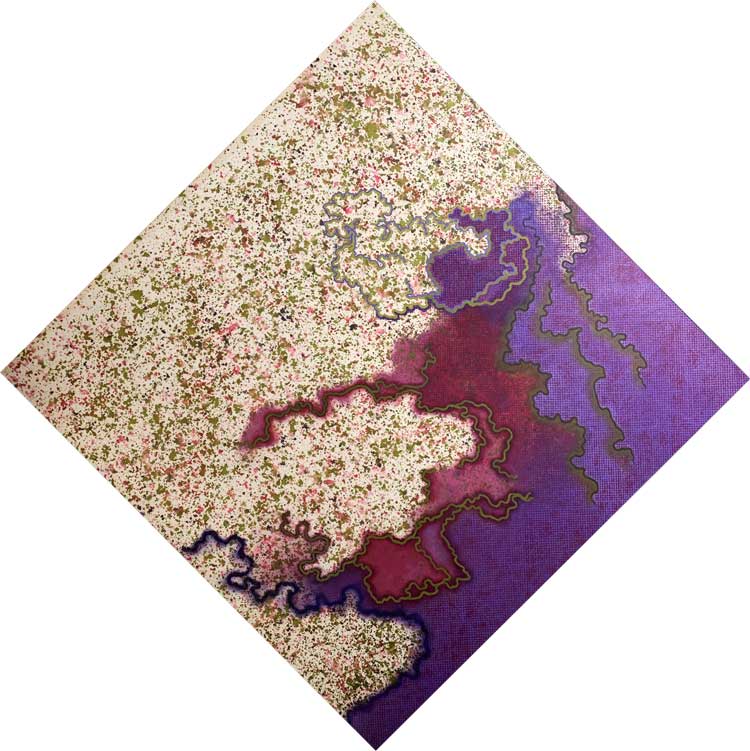
Harold Cohen, Sentinel, 1966. Mixed media on canvas, 210.8 x 210.8 cm. This work was shown at the 33rd Venice Biennale 1966. Image courtesy Gazelli Art House.
Cybernetics as we think of it today was popularised by the American author and computer scientist Norbert Wiener in the late 1940s. According to Wiener, at a basic level, cybernetics refers to, “the set of problems centred about communication, control and statistical mechanics, whether in the machine or in living tissue”.2 Cybernetic self-regulating mechanisms can include the communication within an observer and between the observer and their environment.
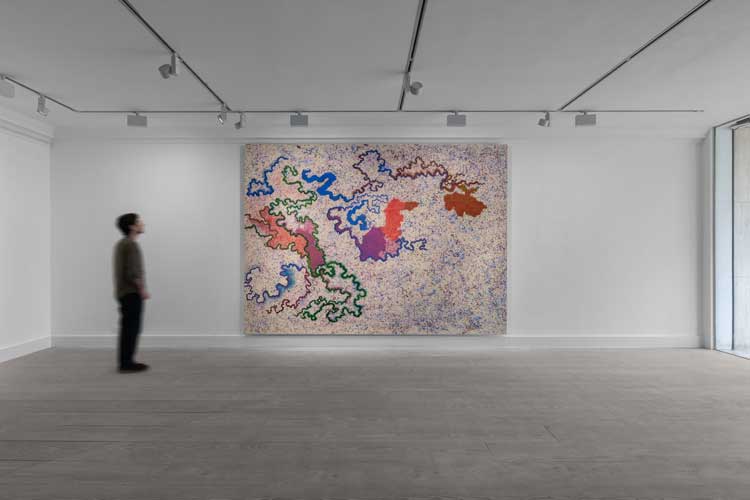
Harold Cohen, Quest, 1966, on view at Gazelli Art House, 2024. This work was shown at the Venice Biennale 1966. Image courtesy Gazelli Art House.
The British-born Gordon Pask, who met Wiener as a student at Cambridge, was a polymath who styled himself a “mechanic philosopher”.3 His theories drew on science, information theory and experimental psychology; crucially, he embodied these theories in artefacts – artworks, computer simulations and “learning machines”, the forebears of today’s artificial intelligence. His interactive system Musicolour (1953) crossed the fields of art, music, theatre and science – producing light and sound that adapted to the performer or audience, resulting in a joint product of human-machine interchange.
By the early 60s cybernetic notions of control, feedback and communication had permeated almost every aspect of technical culture and were making inroads into popular culture too. For artists, the study of how machine, social, and biological systems behave and interrelate to each other offered the possibility of a new framework for art production, one that had the potential to revolutionise art.
In 1961, Cohen (alongside Bernard), was teaching part-time at Ealing College of Art, described by the artist Gustav Metzger as “the leading art school of the day”.4 It was here that Cohen was to become part of the Ealing “experiment”, an important achievement in the history of British art education that took place under Roy Ascott. Ascott had recently arrived in London from King’s College, Newcastle upon Tyne, where he studied under Richard Hamilton and Victor Pasmore, who taught to a “basic design” curriculum. Just before arriving at Ealing, Ascott came across the work of Ross Ashby’s cybernetics of mind and behaviour. At Ealing, he founded an introductory course for new intakes: it was named the “Groundcourse”, as it was based on learning from the ground up (these types of art school courses would later be defined as foundation courses).5 This was based on a cybernetic model of behaviour, feedback and process, stressing interdependence, cooperation and adaptability within group activity.6
As a consequence of Ascott’s central interest in cybernetics, he invited his new friend Pask to give a now famous lecture at Ealing in 1963, in which concepts of feedback and complex systems were presented. Pask argued the need for a practical application of cybernetics that would address itself to the problem of human cognition and consciousness.
Artist Stephen Willats (a student at Ealing at this time), recalls this lecture and Bernard Cohen postulating: “But, Mr Pask, you are trying to make us into machines!” The reply from Pask came: “Yes, but you’ve got infinite variety.”7 This presentation by Pask made a great impression on all present, but particularly on the staff. So startling were these ideas for the potential of art, that the staff retreated, locking themselves into a studio, to discuss and to experiment, setting down notational schemes and theories. What was happening was a formulation of a new arts agenda. Or, as Andrew Wilson has written: “The realisation [dawned] that the unified view of modernism’s essential narrative was untenable.”8
Ascott’s observation that “theory should proceed practice” was a revolutionary idea, breaking from previous concepts of media dexterity that was the main tenant of basic design education. Basic design stemmed from the European Bauhaus model, which emphasised media dexterity - through the handling of different materials, the artist would determine what they wanted to do.9 By contrast, in a cybernetic model of education, students, artworks and the classroom were seen a creative system, the behaviour of which could be altered and regulated by the interactive exchange of information via feedback loops.
Ascott recently commented that the development of Cohen’s work with cybernetic devices “no doubt grew from the intellectual exposure to ideas that Pask had nourished in his historic lecture.”10 Cohen’s response to this event can be seen in a series of paintings to do with notation and systems changing through time. A selection was exhibited at Robert Fraser Gallery in 1963. Cohen’s statement in the catalogue directly referenced cybernetics: “[Painting] is self-analytical, self-critical and possessed of this finely balanced feedback system, self-controlling.” The influence of the new approach introduced by Ascott is apparent in this point made by Cohen about communications: “[Painting] makes communication possible, and much of what is communicated is concerned with the mechanics and processes of communication.”11
This approach has similarities with what Frieder Nake, the computer art pioneer and peer of Cohen, has characterised as: “Think the work, don’t make it.”12 Again, this is a radical approach as now there is not one work, but a range of possible realisations, schemata, methods and techniques to generate works. This leads to the possibility of the generation of an entire family of works. For Cohen, the artwork becomes a means of externalising these concepts.
Cohen incorporated these ideas into his other part-time teaching. At the Slade School of Art (concurrent with his Ealing position), his courses with titles such as “Notation” and “The Problems of Language”, linked abstraction with rigorous thinking. In 1964, his teaching was described in a report as “centred around the question of language and communication in general, and of painting considered as a language”.13
By early 1968, Cohen was questioning how language could be externalised through art and public display via new modalities. Writing in Studio International, in response to a visit he made to Expo 67 in Montreal, he postulated: “Why must a painter find himself in so totally private a situation in a society abounding in the most sophisticated techniques for public address and public presentation ever known? (Is this the question or the answer?)”14 Expo 67 became known for its multimedia audiovisual presentations such as the Czechoslovakian Kinoautomat, an interactive film in which the audience decided the storyline from a range of possible scenarios by pressing buttons by their seats, the votes tallied by computer. Cohen seemed particularly impressed by Diapolyecran, also in the Czech pavilion, a 32ft-wide wall comprising 112 cubes with 2ft square faces, each cube fitted with two computer-controlled slide projectors, creating, he writes, a “quite breathtaking” immersive moving image “mosaic wall”.
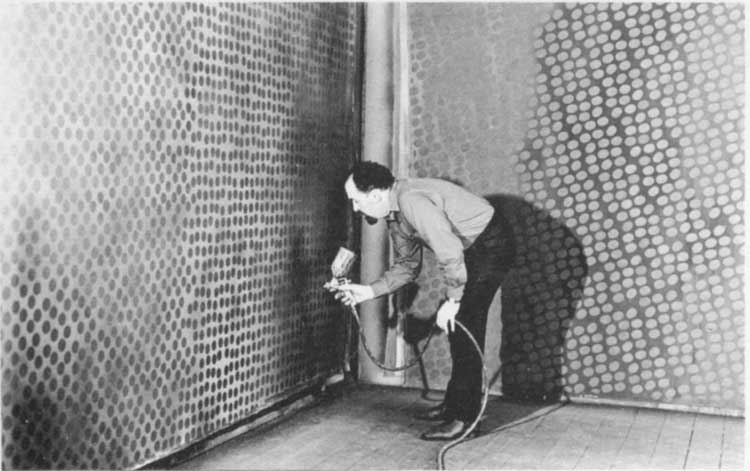
Harold Cohen in his studio, photographed by Robyn Kempster, from the June 1968 issue of Studio International, page 312.
In the summer of 1968, Cohen visited the Cybernetic Serendipity exhibition in London, which, in curator Jasia Reichardt’s words, “dealt broadly with the demonstration of how man can use the computer and new technology to extend his creativity and inventiveness”.15 Later that year Cohen set off for California where, starting his journey of computing, he described being “baffled but overwhelmed by the code elements that opened in front of my eyes”.16
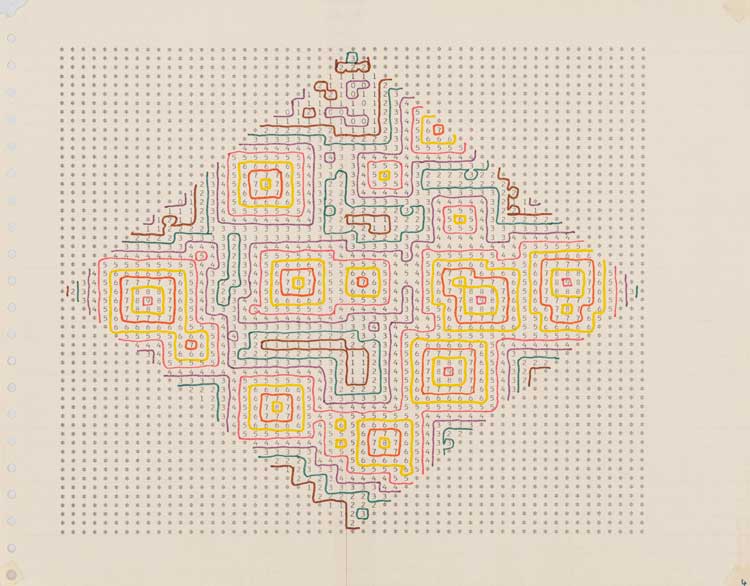
Harold Cohen, Untitled (i23-3451), 1969. DITRAN output and coloured felt tip on paper, 28 x 35.6 cm. Image courtesy Gazelli Art House.
As Cohen’s art is rooted in European painting, this had a major bearing on how he made his choices using the computer – his visual representation is founded in human cognitive structures. He became interested in the concept of writing a program to do some of the things humans do when they make representations and thus possibly learning more about the nature of representation. He asked: “By what curious act of imagination does one pack a lifetime of experience as a colourist into half a dozen lines of code?”17 Cohen’s results of this near 40-year question – AARON’s drawings – enter into the evidence of what is known about human intelligence regarding the visual.
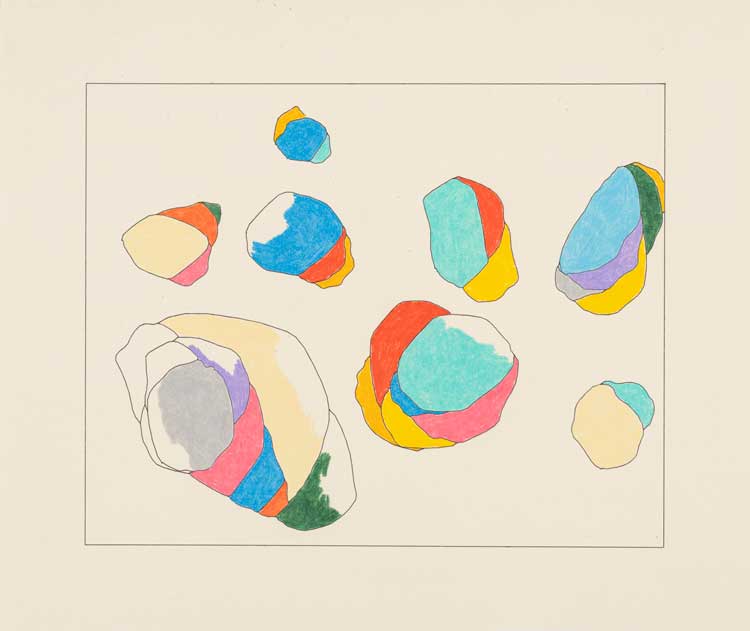
Harold Cohen, Untitled (73DI-CYC-3-1), 1973. Unique plotter drawing in ink and pencil on paper, 31.6 x 36.5 cm. Image courtesy Gazelli Art House.
The digital as an art space recalls Pask’s “aesthetically potent environments”.18 For Pask, an aesthetically potent environment is a system that evolves independently or in interaction with a participant. Closely allied is Pask’s Conversation Theory, exemplified through his artwork Colloquy of Mobiles, on view at Cybernetic Serendipity. The theory is about learning behaviour occurring through circularly causal feedback-based conversations between entities and it is this that ultimately makes knowledge explicit. Pask’s Colloquy incorporated theories of self-organising systems, communication, learning and evolution through simulation of biological processes – its robotic parts interacted with the exhibition visitors and each other, modifying their behaviour as they did so.
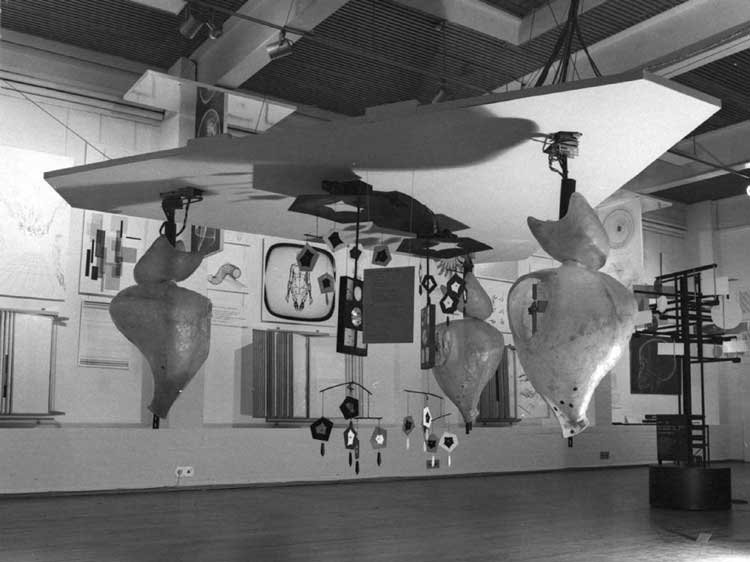
Installation view of Cybernetic Serendipity, Institute of Contemporary Arts, London, 1968, showing Gordon Pask’s Colloquy of Mobiles (hanging from ceiling, foreground). © Cybernetic Serendipity.
Through this cybernetic interpretation, it is possible to see Cohen’s relationship with AARON as that of having conversations about behaviour – the act of artmaking, through code, within an aesthetically potent environment. AARON becomes a collaborator with the artist’s other self. Cohen believed the creativity lay in “the dialogue between program and programmer”.19 Indeed, desiring a fuller dialogue with the machine, from mid-2010 he started to paint again, on top of AARON’s underpainting, to provide, he said, “some of the qualities which the program couldn’t do”.20 Thus, the program goes further than mere tool or even an assistant – Cohen achieved a true symbiosis between human and machine.
-Hank-Morgan.jpg)
Harold Cohen with Painting Machine at Boston Computer Museum, 1995. Photographer Hank Morgan, image courtesy Gazelli Art House.
References
1. Harold Cohen lecture given at Tate, London, 27 April 2004. See also: Reviews: Harold Cohen at Tate Modern, by Catherine Mason, Computer Arts Society PAGE, No 57, Summer 2004.
2. Cybernetics: Or Control and Communication in the Animal and the Machine by Norbert Wiener, Paris, Hermann & Cie & Camb Mass: MIT Press: 1948.
3. The Cybernetics of Gordon Pask by Bernard Scott. In: Gordon Pask, Philosopher Mechanic: An Introduction to the Cybernetician’s Cybernetician, edited by R Glanville and KH Müller, published by Echoraum, Vienna, 2007, pages 29-52.
4. Gustav Metzger interview with author, 11 July 2003.
5. Roy Ascott communication with author, 4 March 2024.
6. Telematic Embrace: Visionary Theories of Art, Technology and Consciousness, by Roy Ascott, edited by Edward Shanken, Berkeley, Los Angeles & London: University of California Press, 2003.
7. As recalled by Stephen Willats, communication with author, 16 February 2024.
8. Stephen Willats. Work 1962-69, by Andrew Wilson, Raven Row.
9. A Computer in the Art Room: The Origins of British Computer Arts 1950-80, by Catherine Mason, published by JJG, Norfolk, 2008.
10. Roy Ascott communication with author, 4 March 2024.
11. Harold Cohen, catalogue of an exhibition 24 September 1963 to 19 October 1963, Robert Fraser Gallery, London, 1963.
12. Frieder Nake, Georg Nees & Harold Cohen: Re:tracing the origins of Digital Media, keynote address at RE:TRACE 7th International Conference for Histories of Media Art, Science and Technology, 2017.
13. Minutes of the Slade Subcommittee 31 January 1964, quoted in William Coldstream by Bruce Laughton, published by New Haven, Conn: Yale University Press, 2004, page 224.
14. Comment, by Harold Cohen, Studio International, January 1968, volume 175, No 896, page 2.
15. Cybernetic Serendipity: The Computer and the Arts, edited by Jasia Reichardt, Studio International special issue, 1968.
16. As told to Frieder Nake, quoted in Georg Nees & Harold Cohen: Re:tracing the origins of Digital Media, keynote address at RE:TRACE 7th International Conference for Histories of Media Art, Science and Technology, 2017.
17. Harold Cohen, communication with author, 23 May 2011.
18. Gordon Pask: Cybernetic Polymath, by Maria Fernández, Leonardo, 2008, volume 41(2), pages 162-168.
19. Harold Cohen, as reference 1.
20. Harold Cohen and AARON: Collaborations in the Last Six Years (2010-2016) of a Creative Life, by Louise Sundararajan, Leonardo, 2021, volume 54 (4), pages 412-417.
• Harold Cohen: Refactoring (1966-74) is at Gazelli Art House, London, until 11 May 2024. Harold Cohen: AARON is at the Whitney Museum of American Art until 19 May 2024.
• To order a 50th anniversary reprint of Cybernetic Serendipity: The Computer and the Arts, edited by Jasia Reichardt, Studio International special issue, 1968, click here.